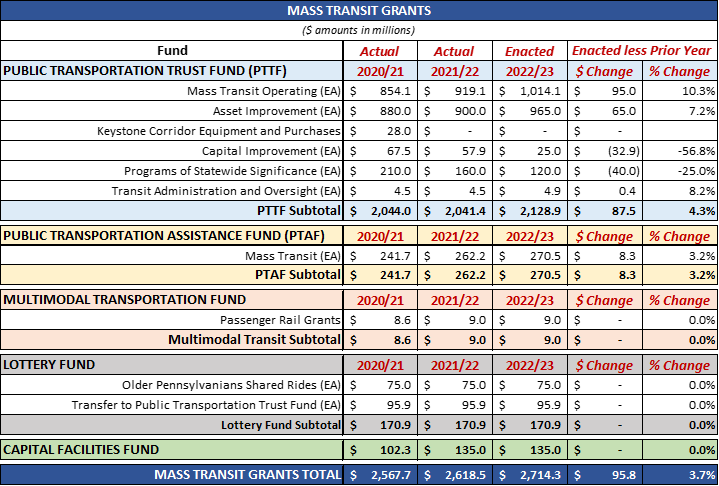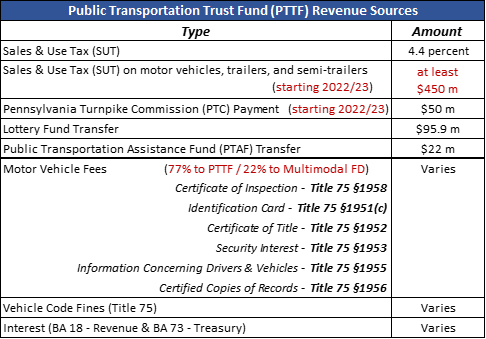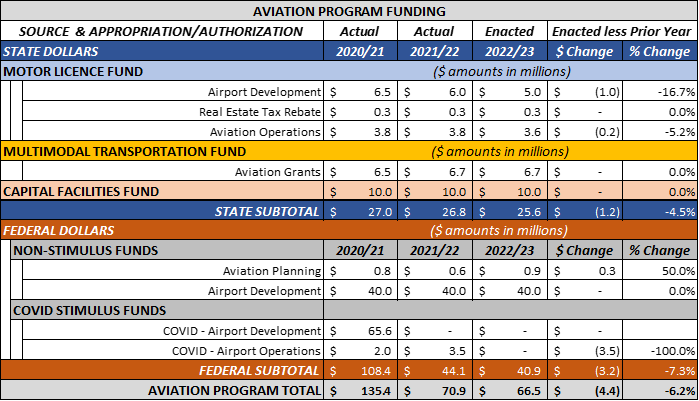PennDOT Multimodal Transportation
By Gueorgui Tochev , Senior Budget Analyst | 3 years ago
The deputate for Multimodal Transportation, at PennDOT, was created by Act 89 of 2013. As provided by the word’s definition, the deputate administers multiple modes of transportation. Programs housed under its umbrella include Public Transportation, Rail, Freight, Ports, Waterways, Bicycle & Pedestrian, and Aviation.
Unique to the deputate are the various funding sources that it utilizes to perform its duties. As statutorily dictated by Act 89 of 2013, annual Pennsylvania Turnpike Commission (PTC) payments are reduced from $450 million to $50 million starting in 2022/23. In turn, at least $450 million would be transferred from Sales and Use Tax (SUT) on motor vehicles, trailers, and semi-trailers, in lieu of the decrease to PTC payments. As the table below highlights, PTC payments support Public Transportation. While the law provides for utilization of SUT, practically speaking, those proceeds are taken away from the General Fund and diverting them will lead to budgetary challenges in the future. As discussed in the Transportation Revenue Options Commission’s (TROC) final report, the General Assembly must find ways to diversify the revenue stream supporting PennDOT and, given that current public transportation allocations fall short of required needs, provide additional support specifically for those needs.

As we analyze the Multimodal deputate, we can take a deeper look at the programs that it’s comprised of along with the funding streams they use.
Public Transportation
Public Transportation offers an accessible alternative to gridlocked communities, individuals who do not own a vehicle, and ever-changing gas prices. From an environmental standpoint, it provides a cleaner alternative to driving, which also reduces traffic congestion. Currently, the Commonwealth provides more than $1.5 billion annually to support Mass Transit. PennDOT manages operating and capital investments for 34 fixed-route systems. As defined by 49 CFR Part 37, Sec 37.3, fixed-route refers to a transit service that is regularly scheduled and operates over a set route, including local bus, light and commuter rail services. Further, the department oversees 44 community transportation systems providing shared-ride services, 13 intercity bus routes, and Keystone Corridor and Pennsylvanian Amtrak services. To learn more about each county’s public transportation services and programs map, information can be found on the department’s website.
Pertaining to public transportation, we also must look at the composition of its funding stream. As highlighted in TROC’s final report, the current funding allocation does not fully meet the current need. The importance of the program’s benefits should be an integral reason that the unfunded needs demand action by the General Assembly. As highlighted in TROC’s report, public transportation, and passenger rail’s unfunded need amounts to $1.1 billion. Executive Authorizations that provide funding for public transportation include the following.
- Mass Transit Operating – provides funding for transit operations within the Public Transportation Trust Fund (PTTF) as provided within Act 44 of 2007 and Act 89 of 2013. Both acts made changes to Title 74, specifically §1513. Financial assistance under this authorization shall be matched by local or private cash funding in an amount not less than 15 percent of funds being provided, unless such match has been waived by the General Assembly for a particular fiscal year. The annual financial assistance received by each qualifying organization consists of:
- Its base operating allocation multiplied by 1.0506
- An additional amount which is allocated using the following distribution formula:
- 25% of the award amount is allocated based on the number of passengers. The actual amount received by each organization is calculated as such:
- Total amount of available funding multiplied by 0.25.
- Product under (a) multiplied by total number of the local transportation organization’s number of passengers.
- Product under (b) is divided by the total number of passengers for all local transportation organizations.
- 10% of the award amount is allocated based on the number of senior passengers to offset free fares for such passengers. Each organization’s amount is calculated as such:
- Total amount of available funding multiplied by 0.10.
- Product under (a) multiplied by total number of the local transportation organization’s number of senior passengers.
- Product under (b) divided by the total number of senior passengers for all local transportation organizations.
- 35% of the award amount is allocated based on the number of revenue vehicle hours, with each organization’s amount calculated as such:
- Total amount of available funding multiplied by 0.35.
- Product under (a) multiplied by total number of the local transportation organization’s number of revenue vehicle hours.
- Product under (b) divided by the total number of revenue vehicle hours for all local transportation organizations.
- 30% of the award amount is allocated based on the number of revenue vehicle miles, with each organization’s amount calculated as such:
- Total amount of available funding multiplied by 0.30.
- Product under (a) multiplied by total number of the local transportation organization’s number of revenue vehicle miles.
- Product under (b) is divided by the total number of revenue vehicle miles for all local transportation organizations.
- Asset Improvement – includes funding for asset improvement activities within the Public Transportation Trust Fund (PTTF) as provided by Act 44 of 2007 and Act 89 of 2013, which amended Title 74 (Transportation). As Title 74 §1514 lays out, such activities encompass:
- Essential asset improvement projects.
- Standard replacement of existing assets, that have exceeded their useful life.
- Projects that extend the useful life of an asset.
- Acquisition of new assets.
It should be noted that asset improvement funds shall be matched by local or private cash funding in an amount not less than 3.33 percent of funds being provided, unless such match has been waived by the General Assembly for a particular fiscal year. Furthermore, funds under this authorization are distributed based on the following percentage basis:
- 69.4% to a Metropolitan Transportation Organization for the counties of Bucks, Chester, Delaware, Montgomery, and Philadelphia (SEPTA).
- 22.6% to a local transportation organization existing under the Second-Class County Port Authority Act (Allegheny County Port Authority).
- 8% to other local transportation organizations existing as primary providers of public transportation for counties not included in (1) or (2).
- Capital Improvement – this executive authorization supplies funding for capital improvements within the Public Transportation Trust Fund (PTTF) as provided by Act 44 of 2007 and Act 89 of 2013, which amended Title 74 (Transportation). Under §1517 of Title 74, funds are allocated to local transportation organizations based on a distribution formula that has two components:
- Local transportation organization’s number of passengers multiplied by the available capital improvement funding.
- Product derived under (1) is divided by the sum of the passengers for all qualifying local transportation organizations.
- Programs of Statewide Significance – the authorization includes funding for Programs of Statewide Significance within the Public Transportation Trust Fund (PTTF), provided by Act 44 of 2007 and Act 89 of 2013, which amended Title 74 (Transportation). Specifically, §1513 of Title 74 provides that such programs shall include:
- Persons with Disabilities program – provides reduced fares to persons with disabilities.
- Intercity passenger rail and bus services programs.
- Community transportation.
- The Welfare-to-Work program and matching funds for similar federal programs.
- Technical assistance, demonstration, and emergency.
- Transit Administration and Oversight – this executive authorization provides for administrative coordination, planning and support for Public Transportation Trust Fund (PTTF) operations. Statutory authority is included within Act 44 of 2007.
- Mass Transit - the executive authorization provides grants to transit systems having prior Public Transportation Assistance Fund (PTAF) debt obligations, as authorized in §9511.13, Section 8 (B) of Act 44 of 2007.
- Transfer to Public Transportation Trust Fund (PTTF) – the authorization provides for the transfer from PTAF to PTTF per Act 44 of 2007, §9511.13 Section 9 (1)(V).
- Passenger Rail Grants - deliver support for intercity rail and rail grants that improve the mobility and the quality of life for urban and rural Pennsylvanians and enhances economic activity throughout the Commonwealth as required by Act 89 of 2013. Funding is provided within the Multimodal Transportation Fund.
- Older Pennsylvanian Shared Rides - Provides funds to transportation agencies for the provision of Shared Ride Demand Responsive transportation at a reduced fare for Pennsylvanians age 65 and older. The statutory authority is the State Lottery Law. Annual expenditure authority is granted via executive authorization.
- Transfer to Public Transportation Trust Fund (PTTF) – the authorization provides funding for the transfer from Lottery Fund to Public Transportation Trust Fund per Act 44 of 2007.
- Capital Facilities Fund – utilizes funding to meet financial costs of capital projects authorized by capital budget acts for mass transit, rail freight and aviation. Fund revenues are derived from the sale of general obligation debt, authorized within the Capital Facilities Debt Enabling Act (Act 67 of 2004), and interest earnings.

Exploring the chart above, it is evident that much of the funding related to the public transportation program comes from two sources: the Public Trust Fund (PTTF) and the Public Transportation Assistance Fund (PTAF). A quick overview of the revenue sources for each fund is displayed below.


As we continue to navigate through Multimodal Transportation, the rest of the programs receive most of their funding through the Multimodal Transportation Fund and a small portion via the Motor License Fund.
Rail Freight
Few of us are aware that the commonwealth leads the nation in terms of the number of operating railroads (65) and is near the top in terms of total track milage (> 5,600 miles). The vast network, managed by PennDOT, can be viewed on Pennsylvania’s railroad map. Grant funding is available through the Rail Freight authorization. As we look at current funding levels, it’s worth noting that the program has additional unmet annual needs, totaling $10 million, as mentioned in TROC’s report.

- Rail Freight Grants – the executive authorization provides support for rail grants, which improves the mobility and the quality of life for urban and rural Pennsylvanians and enhances economic activity throughout the Commonwealth as required by Act 89 of 2013. Funding is provided through the Multimodal Transportation Fund.
Aviation
Pennsylvania ranks 16th in the nation, as it relates to public aviation facilities, heliports, and seaplane bases. With 124 airports, the aviation industry is home to more than 300,000 jobs. Furthermore, the commonwealth aids 228 private-use airports and 280 private-use helipads. Our program review must also include current unmet needs. As highlighted by the Transportation Revenue Option Commission, the aviation program has additional annual needs that amount to $10 million.
Appropriations utilized by the program for funding purposes include:
- Airport Development - provides airports throughout the state with grants to assist in the maintenance and improvement of Pennsylvania's airport facilities. The statutory authority for this appropriation is Act 120 of 1970, which established the Department of Transportation and Act 164 of 1984.
- Real Estate Tax Rebate - provides airports throughout the state with grants to assist in the maintenance and improvement of Pennsylvania's airport facilities. The statutory authority for this appropriation is Act 120 of 1970, which established the Department of Transportation and Act 164 of 1984.
- Aviation Operations - maintain and operate the Bureau of Aviation. The statutory authority for this appropriation is Act 120 of 1970 and Act 164 of 1984.
- Aviation Grants - provide support for aviation grants that improve the mobility and the quality of life for urban and rural Pennsylvanians and enhances economic activity throughout the commonwealth as required by Act 89 of 2013. Funding is provided by the Multimodal Transportation Fund.

Other Multimodal Grants
- Transfer to the Commonwealth Financing Authority - Any funds not allocated to the Multimodal Transportation Fund for PennDOT shall be transferred to the Commonwealth Financing Authority to fund eligible programs to support public transportation, intercity bus, intercity rail, aviation, rail, ports and bicycle and pedestrian facilities options that improve the mobility and the quality of life for urban and rural Pennsylvanians and enhances economic activity throughout the commonwealth as required by Act 89 of 2013 §2104(4).
- Statewide Program Grants - Support public transportation, intercity bus, intercity rail. aviation, rail, ports and bicycle and pedestrian facility options that improve the mobility and the quality of life for urban and rural Pennsylvanians and enhances economic activity throughout the commonwealth as required by Act 89 of 2013.
- Ports and Waterways Grants – PennDOT’s ports program was organized to oversee and administer the issuance of state funding to PhilaPort, Port of Pittsburgh, and Port of Erie. Funding aids in support for ports and waterways options for grants that improve the mobility and the quality of life for urban and rural Pennsylvanians and enhances economic activity throughout the commonwealth as required by Act 89 of 2013. The Transportation Revenue Options Commission’s final report identified an additional annual need of $10 million, related to those grants.
- Multimodal Administration and Oversight - Funds support aviation, rail freight, passenger rail, ports and waterways options, and bicycle and pedestrian grants that improve the mobility and quality of life for urban Pennsylvanians and enhances economic activity throughout the commonwealth as required by Act 89 of 2013.
- Bicycle and Pedestrian Facilities Grants - provide support for bicycle and pedestrian facilities grants that improve the mobility and the quality of life for urban and rural Pennsylvanians and enhances economic activity throughout the commonwealth as required by Act 89 of 2013. It’s worth noting that the Transportation Revenue Options Commission identified an unmet annual need of $18 million, related to those grants.
- PennPorts PRPA Debt Service - Commonwealth obligation to make payment on Philadelphia Regional Port Authority debt service as authorized in the General Appropriation Act of 2022 (Act 1-A).

As we conclude our discussion of multimodal transportation programs, the multitude of programs along with the benefits associated with those programs, should serve as a reminder to the General Assembly of the enormous social and economic ramifications of not funding those programs adequately.
